DEVELOPMENT OF AN OPTIMIZATION MODEL FOR DECISION MAKING IN BUILDING RETROFIT PROJECTS
DOI:
https://doi.org/10.34641/clima.2022.435Keywords:
Energy, Indoor Environmental Quality for well-being in energy-efficient & retrofitted buildingsAbstract
Retrofitting of existing buildings offers significant opportunities for improving occupants’ comfort and well-being, reducing global energy consumption and greenhouse gas emissions. This is being considered as one of the main approaches to achieve sustainability in the built environment at relatively low cost and high uptake rates. Although a wide range of retrofit technologies is readily available, methods to identify the most suitable set of retrofit actions for particular projects are still a major technical and methodological challenge. This study presents a simulation-based multi-objective optimization model to quantitatively assess technology choices in a building retrofit project (a combination of TRNSYS, and MOBO optimization freeware). This model is employed to assess a school building retrofit project as a case study to illustrate the practicability of the proposed approach, and therefore, the final decision (set of non-dominated solutions) for optimum building retrofit. The study starts with the individual optimization of objective functions focusing on building’s characteristics and performance: primary energy consumption, global costs, and thermal discomfort hours. Then the proposed multi-objective optimization model is used to study the interaction between these conflicting objectives and assess their trade-offs.




